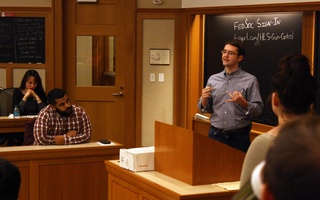The use of guns in America has always bewildered me. I remember receiving a two-week leave of absence from the Israeli Defense Forces and visiting relatives in New York. We rented a car and drove all the way to beautiful Maine, where we encountered a gun store. In the store, I saw the same M-16 I was using in military patrols on Israel’s borders. My American relative, a young man who has never seen a gun shot before, could buy an M-16 and leave the store in less than 15 minutes. To me, that situation couldn’t have been more absurd.
In 36 states, there are no legal requirements for gun registration. No permit is needed and no license is necessary to purchase and own a firearm, whether it is a rifle, shotgun, or handgun. Furthermore, in gun shows around the country, one may buy a gun from a private seller even without a rudimentary background check. Nearly 40 percent of gun transactions in the United States are the product of private party sales that are bound to the same rules as those in gun shows. Hence, they require no background check. When I first learned of this, I was dumbstruck. My perception of owning a gun couldn’t be more different.
Almost five years ago, I joined the IDF. That day, I was surrounded by guns for the first time. Before being able to hold one, I went through a fairly extensive background check which included checking my psychological status.
A few days later, with the authorization of the base commander, a colonel with 30 years of service in his record, we received our M-16 assault rifles. The armory is the most secured place in base, guarded 24/7 and open only during daylight hours. After receiving our guns, my teammates and I learned almost everything about our weapons: who made them, the name of every single part, how to handle and clear gun jams, how to assemble and disassemble our weapons, how to clean them properly, and how to load and fire.
I remember spending hours practicing how to shoot. We would yell “Fire!” instead of actually shooting. Eventually, after our commanders approved, we went to the range with live ammunition. However, we were still not allowed to use the automatic stance of our guns (the same stance Stephen Paddock, the shooter from Las Vegas, was able to use thanks to certain modifications).
The training was taxing and hectic, and for every mistake we paid dearly: Staying on base while your friends got to go home was the most common punishment. Weapons safety is disciplined into all soldiers repeatedly throughout their service, starting in boot camp and going all the way to the last time a soldier will use a gun. All of that time and all of those resources are dedicated in order to instill in every soldier a profound understanding of the precarious character of his or her weapon.
There is a huge gulf, then, between my understanding of the gun culture in the IDF and gun culture in many places in the United States.
A few years after I enlisted in the IDF, I became an Army officer. I still remember the stress that involved every day of shooting with my soldiers. Making it back to base with everyone safe and sound was my primary objective. Being so close to such a deadly tool teaches one how dangerous it truly is.
But you don’t need to shoot a gun in order to understand how dangerous it is. There are more than 33,000 annual gun deaths in the U.S. This number is so high that the death toll between 1968 and 2011 by guns alone surpasses the amount of US soldiers killed in all wars from the Civil War to the war in Iraq.
It is clear that we will never be able to prevent every mass shooting that happens in America. Since there are more guns in the United States than there are in any other country, people with malicious intentions, in some cases, will still be able to acquire guns even if gun laws are changed.
Nonetheless, changing the gun culture will have a tremendous effect that will only grow with time. Just as one is required to pass both a written exam and a behind-the-wheel test in order to obtain a driver’s license, so should be the case with obtaining a license to own a far deadlier tool, a gun. Similarly, license renewals that include practices in a range and written exams should be implemented. This will not erase the problem instantly, but it will mitigate it.
Moreover, we can make it harder for criminals, mentally unstable people, and terrorists to own a firearm. Extensive background checks and mental reviews are needed and will make it more difficult for people who are not mentally stable, law-abiding citizens to acquire guns. Toughening the criteria to obtain firearms will make it much more difficult to commit mass shootings and accidents involving a misuse of guns. A terrorist with a knife can do far less damage than one with a rifle, and no kid will play with their parent’s gun if that gun wasn’t around, or, at least, safely stored.
Gun laws need to change. Getting a gun, especially assault rifles, should not be this simple. A good starting point will be to completely prohibit the sale of military grade assault rifles, like those used by Stephen Paddock and Devin Kelley. These guns belong on military bases and behind enemy lines, not on the streets of American towns.
Shlomo T. Zach-Cahlon ’21 is a Crimson Editorial comper in Canaday Hall.
Read more in Opinion
Playing the Wrong GameRecommended Articles
-
Guns, Migrations, and JailsEffective gun control will require new strategies around the country. But more fundamentally, America needs integrated economic, legal, and social solutions to the deep-seated racial disparities that are at the root of urban violence around the country.
-
A Disheartening DebateThe fact that we even have to confront such a question is indicative of the magnitude of the gun problem in this country.
-
 Law Groups Debate Gun Control
Law Groups Debate Gun Control -
Some Concluding ThoughtsThe lesson I derive from all this is to be cautious and humble. I often find things to be a lot more complex and subtle after I have thought them over for some time than I do after examining them one or even several times.
-
 Longwood Students Protest Gun Violence
Longwood Students Protest Gun Violence













